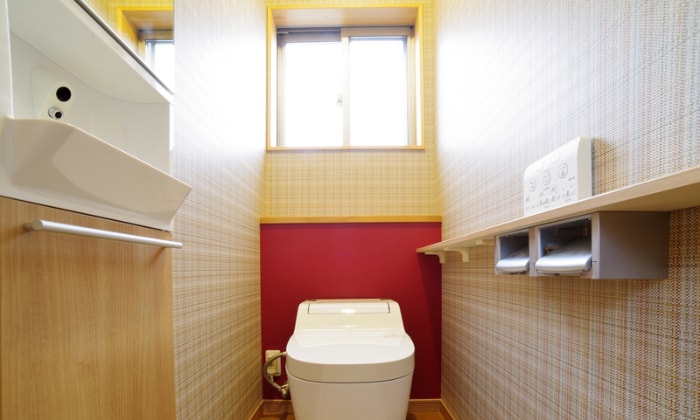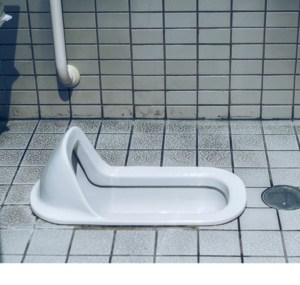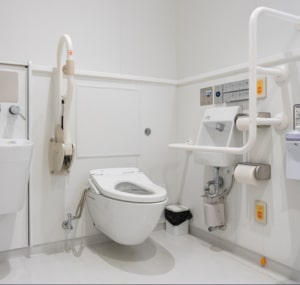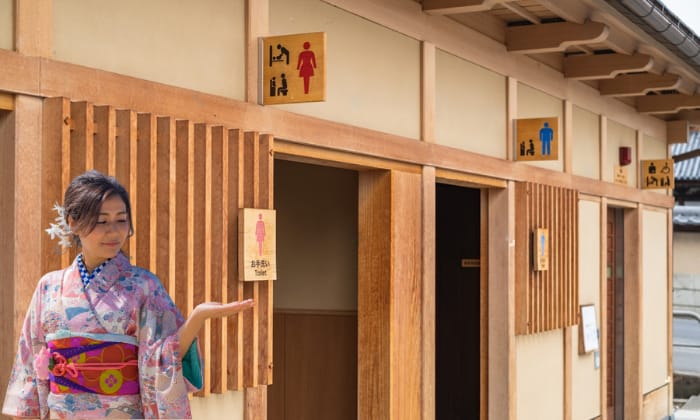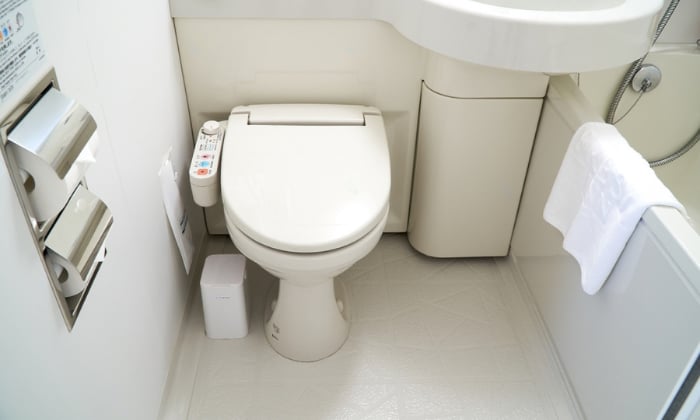If you’ve been to Japan, you must have been confused with the many shapes and features of their toilets in public bathrooms. You probably see Japanese toilets on the floor and high-tech models. To reduce the guesswork, let’s teach you how to use a Japanese toilet properly.
All you need to do is to get familiar with the terms so you’ll know what button to choose. You should also know how to position yourself over the bowl so you don’t make a bigger mess.
Here are directions on using any type of Japanese toilet, along with videos and pictures.
Table of Contents
Types of Toilets in Japan and How to Use
Japan offers three toilet options: the traditional Japanese toilet, the Western style, and a multifunction unit. Let’s teach you how to use each toilet type correctly.
1. Traditional toilet
If you visit older buildings and homes, you can easily find a Japanese style toilet.
What does a Japanese toilet look like? It looks like a tiny urinal set placed directly into the floor. To use it, you simply have to squat.
Don’t just squat right away. The direction is crucial when you use a Japanese squat toilet.
- When you enter the stall, face the traditional Japanese toilet seat.
- Position yourself over the bowl.
- Pull your pants below your knees, or lift your skirt.
- Bend your knees and squat all the way down. Your feet should be flat on the floor, and move your center of gravity forward to get more stability.
- Once you’re done with your business, grab a tissue and flush. Others flush automatically, so don’t get flustered when these toilets make a sudden flushing noise.
TIP: Try not to touch anything because some people pee incorrectly and might have sprayed some urine on the floor. Others also use their feet to flush the toilet.
2. Western style
The Japanese Western-style toilet is what you normally see in common bathrooms in foreign countries. It has an elevated toilet seat and a cistern at the back. Sometimes, it has a small sink above the cistern to wash your hands, saving space and water.
If you visit high-end places like malls and hotels, you can encounter a more modern model. The fancy toilets come with a control panel to control the washlet.
So, what do the buttons on a Japanese toilet do?
- After doing your business, press Oshiri, a button that cleans your bottom.
- Press Tome to stop the water.
- For women, press Bidet Bide to switch the position of the toilet spray to clean the front. Again, press Tome to stop the cleaning process.
To flush a Japanese toilet bowl,
- Press Nagasu, which is often accompanied by dai (full flush) and sho (half flush) buttons. Dai is recommended to flush after pooping, while sho is for urinating.
- Other electronic toilets use automatic flushing, so you might need to hover your hand to activate the sensor, which is usually placed on the wall and directly above the cistern.
Other basic functions of Japanese toilet buttons
- To change water pressure (Suisei), choose between Jaku (weak) for gentle cleaning or Kyo (strong) for a powerful wash.
- If you like the water to be cold or warm, choose the Ondosettei function to change the temperature setting.
- Benza warms the toilet seat during the winter.
- For women toilets, the synthetic flush sound button comes in handy to conceal the sounds they create when relieving themselves. You can hover your hand over the device to activate the sound.
3. Multifunction toilet
A multifunction toilet is specially designed for mothers, people with disabilities, the elderly, and those with medical conditions. This toilet is large enough to fit a wheelchair or to change baby diapers. Though anyone can use it, it’s common courtesy to give priority to the people mentioned above.
Here’s how you can use it.
- Press the green button outside to open the door.
- Once you’re in, press the close button inside the washroom to lock the door.
- Now, do your business, then clean up.
- Push the flush button on the wall or wave your hand over the sensor. Other toilets use a lever for flushing, so pull it down or twist it.
- Once you’re done, press the red button outside to close the door.
Other basic functions
- Use the Emergency button if you need help. It’s called kinkyu or yobidashi.
- If you want to change diapers, use the baby board.
- The fitting board is perfect for changing clothes.
- While doing your business, you can put your child in the baby chair to wait.
DOs and DON’Ts When You Use Japan’s High Tech Toilets
Dos:
- Do experiment with the water pressure settings. Find the strength that you feel the most comfortable with.
- Do press the Stop button when you make a mistake in choosing a setting in the panel.
- Do check the temperature of the water to prevent irritating your sensitive parts.
Don’ts:
- Don’t use the bidet button to wash your bottom. Bidet in Japan is a front spray, so it’s bidet etiquette to use it for women only.
- Don’t assume that the flush function is only a lever. Automatic toilets use sensors or buttons to flush the toilet.
- Don’t flush before using the bidet because you want to stand up already feeling clean.
Other Guide to Using Toilets in Japanese
- Never Bring The Bathroom Slippers Outside: Most Japanese restaurants have separate slippers to use for the toilet only. You should never get those toilet slippers outside the bathroom because they’re full of germs that might contaminate the area.
- Toilet Paper: Do Japanese use toilet paper? Yes, they do.The Japanese flush down the toilet paper after using it. They even fold the end of the remaining toilet paper roll into a triangle, indicating that the toilet has been cleaned up. But before you do this, make sure that you wash your hands to prevent contaminating the paper with bacteria.
- Use The Right Expression For Toilet: Toilet in Japanese is expressed in many terms like toire, otearai, and keshoshitsu. The translation of toire is a bit blunt, so avoid using it in a formal setting. A more polite way of saying toilet is otearai, keshoshitsu, or senmenjo.
Frequently Asked Questions
How much is a Japanese toilet?
A Japanese self cleaning toilet can cost around $500. These toilets are expensive because they’re equipped with modern technologies like a heated toilet seat and temperature settings.
What is the difference between American toilet and Japanese toilet?
Japanese toilets provide more technological innovations than American ones. They have warmed seats, automatic flushing, and water pressure settings, even in public bathrooms. In America, public toilets are composed only of a simple toilet bowl and cistern.
The bidet function also differs. While the Americans use it to clean the anal part, the Japanese use it for the women’s genitals.
How does a Japanese toilet work?
A Japanese toilet uses smart technology to spray, flush, and dry. You can press the buttons or use a remote control to activate the different functions.
Two sprays are used: one for washing the bottom and another for the front. Meanwhile, the flushing system uses two different amounts of water. You can activate it with a lever, button, or sensor.
Conclusion
Now that you know how to use a Japanese toilet and the proper use of a bidet, you can visit Japanese public bathrooms without feeling confused. You can also consider installing a Japanese toilet in your bathroom for an upgrade. If you want to do your business comfortably, choose the right settings.
Let us know your experiences with Japanese toilets in the comment section below. Feel free to share this article with your friends.
Helpful tips made for you:
- 5 Simple & Easy Steps to Use a Toilet Seat Cover
- Using a Composting Toilet Easily in 5 Steps
- Step by Step to Use a Toilet Auger Effectively

I’m Paulk Webb, and I work as a writer for Saveourwaterrebates. I’m happy to put in the time and effort to conduct market research to identify the most pressing issues faced by households concerning their plumbing. Feel free to check out our guides to get the most informed recommendations for how to solve your problems.



